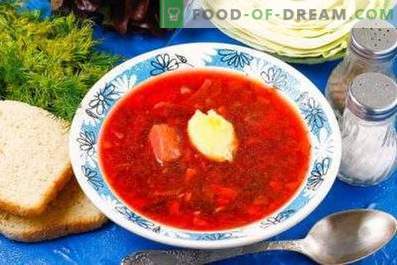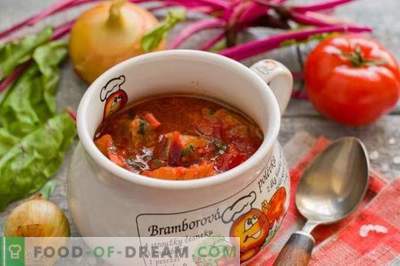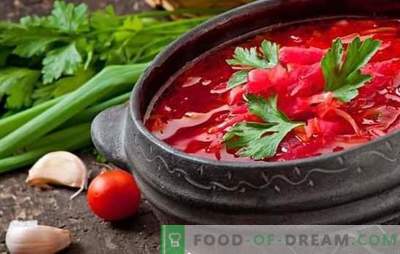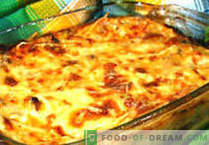
Hot, rich borsch is a traditional dish of Slavic cuisine, a favorite dish of the majority of Russian kings, which has spread widely to the national cuisines of neighboring nations. Borsch is appropriate at any time of the day and in any season.
Judging by the length of its “technological” chain, it is relatively difficult to prepare and is a filling multi-component soup. That is why there is a huge variety of his recipes, which makes it possible to “modify” a dish to suit any preferences.
But any of them necessarily includes the main vegetable component, which determines both its taste, color, and flavor - beets, and because of this borscht belongs to the category of vegetable soups.
Secrets of cooking delicious borscht
- The taste of borscht is primarily determined by the quality of the meat and bone broth, although as an alternative to meat, borscht is sometimes added to finely chopped bacon with garlic and greens. A small yellowish bar aged in the refrigerator gives the dish a distinctive, unique flavor.
- The most sugary beet variety is the Bordeaux variety, which gives the borsch the expected rich burgundy color and sweetish notes. Root crops of this variety have a small size and flat shape.
- Pre-preparation of vegetables is the main feature of borscht preparation, including drastically affecting the color, and this applies primarily to beets. Often it is prepared separately from other components of borscht.
There are several options for its preparation up to the moment of putting it into the finished broth: boiling or baking in whole in the peel and stewing in chopped form. In the latter case, to preserve the color of its pieces sprinkled with a small amount of vinegar, lemon juice or cabbage pickle. With the same purpose in the old borsch was prepared on the basis of beet kvass. For the preparation of the best borschs, in our time, they use specially prepared kvassirovs.
- To prevent the potatoes in the borscht from turning red, beets are cooked separately from them. Beet cut into large strips is put into the broth first and pre-boiled until the broth acquires a delicate amber-golden color, or use beetroot of certain varieties (not vinaigrettes, maroon-red, but striped or even sugar). Only then lay the potatoes. It must be remembered that tomato supplements lengthen, albeit slightly, the cooking time for other vegetables.
- In the world there is nothing tastier than brain bone, as our classic wrote, but meat boiled to readiness, as a rule, is removed from large bones. In no case should their fragments get into the broth.
Large bones occupy a significant amount of saucepans, make it difficult to estimate the thickness of the dish and are rather inconvenient when serving. Meat is more rational to serve, dividing it into portioned pieces of optimal size. But do not divide the portions into too small pieces: stratified meat fibers will give the dish an unappetizing look on the plate.
- Paradoxically, the taste of the finished dressing, and, ultimately, the finished borsch depends on the way vegetables are cut: for example, cutting carrots into straws will make the dish more sweet.
- The second important factor influencing the color of the finished dish is the quality and quantity of tomato paste used in the dressing. Much depends on personal preferences, but his tablespoon per pan with a capacity of 3 liters will not be enough. Puree made from fresh tomatoes or home-made tomato juice is much preferable to tomato paste purchased at the supermarket. Small tomato seeds and Bulgarian pepper chips give a special charm to appetizing vegetable platter in a plate.
- Regardless of the type and taste of the tomato additive, at least a pinch of sugar is added to the dressing, supplementing the beetroot sweetness and wonderfully shading the taste of the finished borscht.
- A precious fragrant gravy with butter and tomato is placed in the broth only hot, so it is prepared in parallel with the preparation of the broth. Borscht refueling should boil at minimum heat until the color changes to darker, but not longer. Otherwise, the fat-soluble vitamins contained in carrots are destroyed and the quality of the oil deteriorates.
- If, in the process of roasting vegetables, a piece of butter is introduced into the dressing, the borsch will acquire a new “sound”. Only this is done immediately before removing the pan from the heat.
- Chopped leafy greens, as a rule, are not passeed, but are added at the final stage of cooking, almost simultaneously with cabbage, in order to preserve the content of vitamins as much as possible. The less boiled “seasoned” borscht, the more useful it is, and the greater the likelihood that it will become a real culinary poem.
A bright fiery dish symbolizes the coziness and strength of the family hearth, makes any meal full-fledged, and is the best evidence of the diligence of the hostess of the house.























